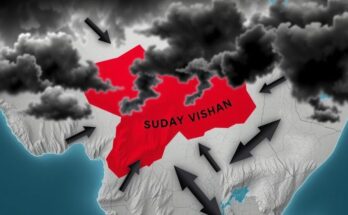The Druze in southern Syria, wary of external threats, have formed the Suwayda Military Council to protect their community post-Assad. The council seeks stability while engaging with larger security factions. Concerns linger over leadership and the council’s reception among Druze leaders as they navigate ongoing regional instability.
The Druze community, primarily based in southern Syria’s Suwayda and Jabal al-Druze regions, has historically remained cautious of external threats. In addition to smaller Druze groups situated near the Golan Heights, they represent a wider network of Druze across Syria and Lebanon. Adhering to a unique faith that blends elements of Islam, Hinduism, and classical Greek philosophy, the Druze have faced severe persecution, particularly from ISIS and amidst the ongoing civil war in Syria.
On February 24, armed Druze factions in Suwayda announced the formation of the Suwayda Military Council. This coalition aims to protect the Druze community against external dangers and government oppression, following the ousting of former President Bashar al-Assad. Despite the regime’s decline, many within the Druze community, such as Ahmed Al Shareef, noted that conditions have not drastically improved, with continued governmental neglect affecting the poorest.
The newly formed council is charged with safeguarding civilians and public property while coordinating with other security factions for regional stability. Although some security has reportedly improved following the decline of Assad-backed gangs, community members remain on guard against groups like Hayat Tahrir al-Sham, which is regarded with skepticism due to its past actions.
Initially established as the Interim Military Council in December following Assad’s government downfall, the Suwayda Military Council emerged as a response to the precarious security situation. Its commander, Tareq Al Shoufi, advocates for mainstreaming the Druze into a unified Syrian army that emphasizes secularism and decentralization. However, the council has faced challenges from prominent Druze spiritual leaders accusing it of separatism.
President Ahmad al-Sharaa, who leads an interim government, has engaged with the Druze delegation to resolve security and economic issues. Nonetheless, there are concerns regarding his leadership history and the potential for Islamic law imposition in a predominantly Druze area. Community sentiments toward al-Sharaa have soured due to perceived indecisiveness in declaring a clear governance structure.
The Suwayda Military Council has adopted a flag reminiscent of the Kurdish-led Syrian Democratic Forces, incorporating the Druze five-pointed star. The council seeks collaboration with the SDF, recognizing shared challenges against terrorism. Reports indicate that Al Shoufi, previously associated with the Syrian Arab Army during protests, leads the council and has garnered local support.
Furthermore, Israeli Prime Minister Benjamin Netanyahu has pledged support for the Druze community in southern Syria, highlighting security concerns. Abu Ras, a leader within the council, has made positive remarks about Netanyahu’s support, particularly targeting al-Sharaa and HTS. Despite armed groups’ historical disorganization, local civilians are optimistic about the council’s potential to advocate for their rights and safety.
The Druze have a historical aversion to radical Islam, with many serving in the Israel Defense Forces. This ongoing initiative reflects a broader effort within the community to assert autonomy and safeguard against future threats while navigating complex political waters in a post-Assad landscape.
The formation of the Suwayda Military Council represents a strategic move by the Druze community in response to ongoing regional instability and the impacts of the Syrian civil war. As they consolidate their forces in the face of external threats, concerns remain about the leadership dynamics and the potential for community division. The council’s commitment to securing the Druze population and advocating for autonomy highlights their resilience in a volatile political environment.
Original Source: www.ndtv.com




